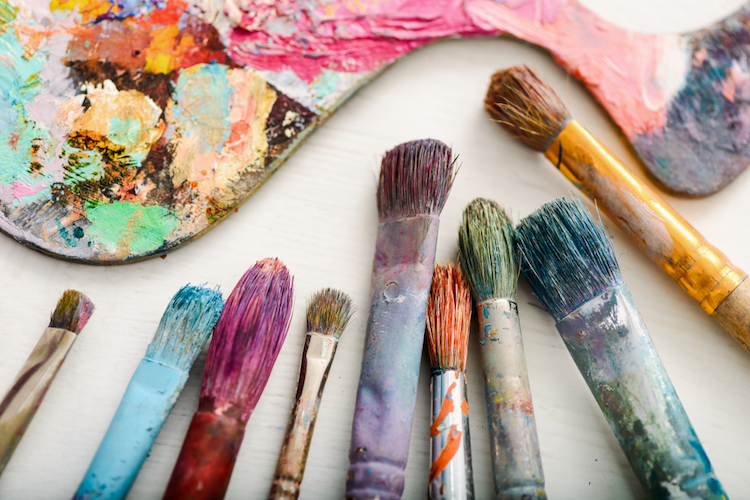Painting is a form of art that allows you to express your ideas, emotions and feelings with the help of a two-dimensional visual language. But to unlock the true secrets and beauty of this artistic kingdom you need to have the knowledge and understanding of it building blocks. The application of these principles, also known as the elements, makes all the difference and takes you from a rookie level to pro level. In order to excel in any art form one needs to comprehend, skillfully analyze and practice it, based on principles and key concepts that it’s built on. If you have a clear understanding and knowledge of these concepts you’ll enjoy your journey that much more. These elements of painting are important when doing any art form, like colorful paint by numbers or free hand painting on canvas.
Generally in Western art, there are six formal elements of art; Color, Tone, Line, shape, Space and Texture. Another element s that is dropped in two-dimensional medium is Form. So basically we have six main elements and in addition to them, you can also call them the extensions of the above six basic elements are Composition, Direction, Size and Movement. To round it off we have 10 elements of painting. With the proper familiarity and understanding of these elements you’ll feel overjoyed and excited every time you pick up the brush to paint.
The usage of these elements makes your painting not only appealing and beautiful; it also gives the painter a feeling of great satisfaction and pride. The best way to practice this is by using paint by numbers online, where you can see these elements coming to life in front of you. These building blocks or fundamentals of painting are just like the tools in a tool box, weapons of a solider or arrows in your quiver. Apply them individually or in combination with each other and see for yourself how they completely change the game of your painting skills. Your painting endeavors will be more professional, classy and mature.
With the skill of these elements in your hand, take liberty to express patterns that represent natural and supernatural phenomena, shed light to narrative themes and create all-inclusive abstract visuals. Use any medium of your choice like Fresco, Water, Oil, Acrylic, Tempera or Gouache on an easel, panel, manuscript or panorama and see how these elements widen your horizon, push your limits, make you overcome your limitations and present you a dozen possibilities. So without further ado let me introduce you to the elements of painting that will change your painting game for good.
1. Color
Color or hues are the soul of every painting; it’s the most important component that sets the tone of the painting and how the viewers feel about it. It can further be divided in three essential parts; Hue, Value and Intensity. Hue is the color, value refers to the lightness and darkness of hue when white or black is added to them and intensity is the aspect of the brightness and how pure the color is. Light intensity means the colors are mute and faint whereas high intensity colors mean vibrant and bright. There are a zillion ways by which the painter can use this element to define their work.
Each color introduced to the painting contributes into the larger picture. With this element one can tap into the different feelings in different capacities and it’s a great manipulative tool that allows the painter to provoke different feelings. Colorful paint by numbers shows you the true power of colors in a painting and how the correct use of color in the right place can make a plain piece of canvas come to life.
2. Line
Line is the point where two elements meet or a fine line that is made by the brush. There should be great emphasis on the lines by the painters as it defines the subject of the painting. Lines are of various types such as implied lines, abstract lines or parallel lines. These lines contour the painting, define the shapes and are the guideline for your painting to the onlookers. Lines are a great tool in your tool box; the right usage can allow a sense of stillness, movement and energy in your painting.
3. Shape
A simplified version of shape is the enclosed area that is created when lines meet but shape has much more to it in the world of painting. Every painting is a hefty mix of shapes in different sizes and forms. Painters educate themselves to see shape in everything to accurately represent the painting. Shapes like circles, rectangles and triangles are common shapes but some shapes are not that well-defined and these closely refer to nature.
4. Space
Space is generated in the painting by the placement of lines, shapes, colors and form. A space can be positive or negative. Positive space means that the area is occupied by an object and negative space means that the area left around, between, through or within the objects. Painters can effectively use this element to draw the attention of the viewers to make a powerful statement or just intrigue them.
5. Texture
The element of texture is very important in a painting as it helps to make you feel an object upon touch. This is very difficult to nail and painters often seek refuge in other elements like lines, color and tone to further accentuate the texture.
6. Composition
This refers to the placement of the painting, where is the subject, what is the background in relation to the subject and every little element you add to the canvas all adds to the composition. Consider unity, balance, coordination, focus and proportion.
Conclusion
This article can be your refresher course or a guideline, whichever way it serves you it will surely take you to the next step of your painting journey. Make sure to put these principals of paintings in your next endeavor and see the difference it makes to your paintings. Paint by numbers online is a wonderful starting point to see all these elements in action.




